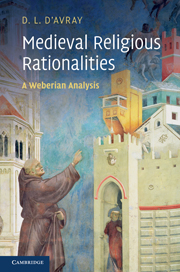Book contents
- Frontmatter
- Contents
- Preface and acknowledgements
- Abbreviations
- 1 Preliminaries
- 2 Medieval values: structures
- 3 Medieval values: dynamics
- 4 The value–instrumental interface in the Middle Ages
- 5 Formal rationality and medieval religious law
- 6 The formal–substantive interface and the dispensation system
- General conclusion
- Bibliography
- Index of manuscripts
- General index
2 - Medieval values: structures
Published online by Cambridge University Press: 05 June 2012
- Frontmatter
- Contents
- Preface and acknowledgements
- Abbreviations
- 1 Preliminaries
- 2 Medieval values: structures
- 3 Medieval values: dynamics
- 4 The value–instrumental interface in the Middle Ages
- 5 Formal rationality and medieval religious law
- 6 The formal–substantive interface and the dispensation system
- General conclusion
- Bibliography
- Index of manuscripts
- General index
Summary
Method
The following account of medieval values or convictions (as defined in the previous chapter) has to be selective if it is not to turn into a summa on medieval religion. The method will be to concentrate on a few examples of medieval convictions or values, and to analyse them via specific passages from sources. (The ‘methodology’ is thus none other than the ‘gobbet’ commentary technique familiar to university teachers and students of history in the British Isles.) For each of the extracts, thousands of others could have been substituted. This is in fact the point: one can take a source sample which bears on a given theme but which is otherwise selected more or less arbitrarily, and find that it leads out in all directions to other key beliefs within the medieval world-view.
Each of the themes selected fitted into a network of interrelated convictions. The ways in which each of these convictions or values was embodied in strong mental images, whether created by experience or in other ways, should also emerge from these analyses. So with each passage the commentary will aim to bring out the two features of conviction rationality: their interconnectedness in a network, and their concreteness.
Spiritual ‘gift economy’
Belief in what we might call a spiritual ‘gift economy’ was an underlying religious conviction which could not have been put concisely into words in the medieval period itself.
- Type
- Chapter
- Information
- Medieval Religious RationalitiesA Weberian Analysis, pp. 31 - 62Publisher: Cambridge University PressPrint publication year: 2010

